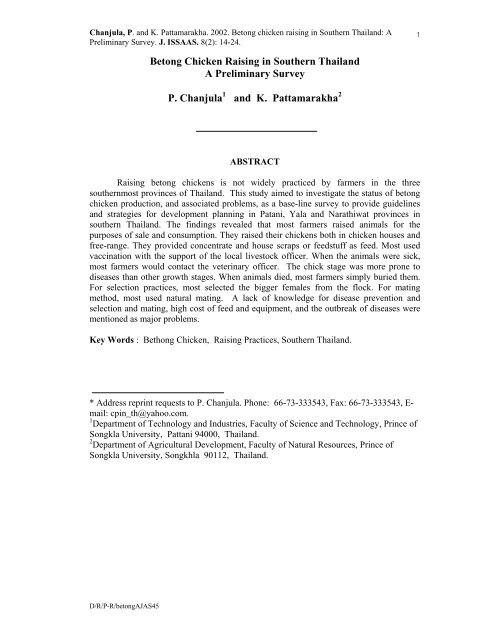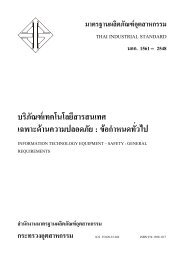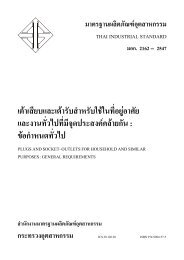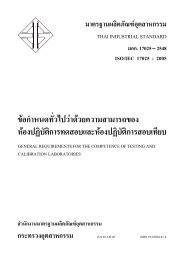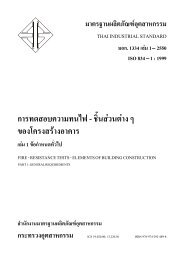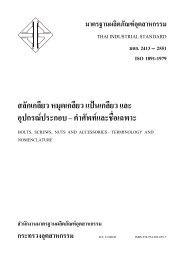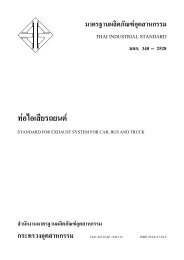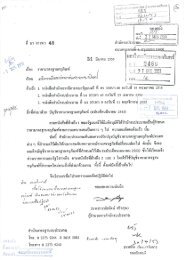Betong Chicken Raising in Southern Thailand A Preliminary
Betong Chicken Raising in Southern Thailand A Preliminary
Betong Chicken Raising in Southern Thailand A Preliminary
Create successful ePaper yourself
Turn your PDF publications into a flip-book with our unique Google optimized e-Paper software.
Chanjula, P. and K. Pattamarakha. 2002. <strong>Betong</strong> chicken rais<strong>in</strong>g <strong>in</strong> <strong>Southern</strong> <strong>Thailand</strong>: A<br />
Prelim<strong>in</strong>ary Survey. J. ISSAAS. 8(2): 14-24.<br />
D/R/P-R/betongAJAS45<br />
<strong>Betong</strong> <strong>Chicken</strong> <strong>Rais<strong>in</strong>g</strong> <strong>in</strong> <strong>Southern</strong> <strong>Thailand</strong><br />
A Prelim<strong>in</strong>ary Survey<br />
P. Chanjula 1 and K. Pattamarakha 2<br />
ABSTRACT<br />
<strong>Rais<strong>in</strong>g</strong> betong chickens is not widely practiced by farmers <strong>in</strong> the three<br />
southernmost prov<strong>in</strong>ces of <strong>Thailand</strong>. This study aimed to <strong>in</strong>vestigate the status of betong<br />
chicken production, and associated problems, as a base-l<strong>in</strong>e survey to provide guidel<strong>in</strong>es<br />
and strategies for development plann<strong>in</strong>g <strong>in</strong> Patani, Yala and Narathiwat prov<strong>in</strong>ces <strong>in</strong><br />
southern <strong>Thailand</strong>. The f<strong>in</strong>d<strong>in</strong>gs revealed that most farmers raised animals for the<br />
purposes of sale and consumption. They raised their chickens both <strong>in</strong> chicken houses and<br />
free-range. They provided concentrate and house scraps or feedstuff as feed. Most used<br />
vacc<strong>in</strong>ation with the support of the local livestock officer. When the animals were sick,<br />
most farmers would contact the veter<strong>in</strong>ary officer. The chick stage was more prone to<br />
diseases than other growth stages. When animals died, most farmers simply buried them.<br />
For selection practices, most selected the bigger females from the flock. For mat<strong>in</strong>g<br />
method, most used natural mat<strong>in</strong>g. A lack of knowledge for disease prevention and<br />
selection and mat<strong>in</strong>g, high cost of feed and equipment, and the outbreak of diseases were<br />
mentioned as major problems.<br />
Key Words : Bethong <strong>Chicken</strong>, <strong>Rais<strong>in</strong>g</strong> Practices, <strong>Southern</strong> <strong>Thailand</strong>.<br />
* Address repr<strong>in</strong>t requests to P. Chanjula. Phone: 66-73-333543, Fax: 66-73-333543, Email:<br />
cp<strong>in</strong>_th@yahoo.com.<br />
1 Department of Technology and Industries, Faculty of Science and Technology, Pr<strong>in</strong>ce of<br />
Songkla University, Pattani 94000, <strong>Thailand</strong>.<br />
2 Department of Agricultural Development, Faculty of Natural Resources, Pr<strong>in</strong>ce of<br />
Songkla University, Songkhla 90112, <strong>Thailand</strong>.<br />
1
Chanjula, P. and K. Pattamarakha. 2002. <strong>Betong</strong> chicken rais<strong>in</strong>g <strong>in</strong> <strong>Southern</strong> <strong>Thailand</strong>: A<br />
Prelim<strong>in</strong>ary Survey. J. ISSAAS. 8(2): 14-24.<br />
INTRODUCTION<br />
<strong>Chicken</strong>s are small domestic animals raised all over the world, ma<strong>in</strong>ly for<br />
consumption of their meat and eggs. Native poultry production is an alternative to<br />
imported meat, thus reduc<strong>in</strong>g the need for imports. In southern <strong>Thailand</strong> there are several<br />
varieties of native poultry such as Nake-nick chicken, Kawchang <strong>Chicken</strong>, Black sk<strong>in</strong><br />
chicken and Thapaow Thong chicken.<br />
The <strong>Betong</strong> chicken is a very popular species which is found <strong>in</strong> the lower zone of<br />
southern <strong>Thailand</strong>. The name “<strong>Betong</strong>” is derived from the name of a district <strong>in</strong> Yala<br />
prov<strong>in</strong>ce, and orig<strong>in</strong>ated from the Langshans variety <strong>in</strong> Ch<strong>in</strong>a, Brought by Ch<strong>in</strong>ese<br />
immigrants (Oboon and Vetchbutsakorn, 1994). The population of <strong>Betong</strong> chickens is<br />
small, but the breed is common <strong>in</strong> some parts of the south, expecially <strong>in</strong> Yala prov<strong>in</strong>ce.<br />
The nature body weight is 2.0 – 2.5 kg. For makes and 1.5–1.8 kg. For females. The<br />
down of the chicks is whitish-yellow <strong>in</strong> color, and the feather are slow to appear. At four<br />
weeks of age, the chicks still have relatively few primaries and secondaries, and these are<br />
narrower and shorter than those of the other native varieties. Young chicks also show no<br />
development of the tail feathers. When the <strong>Betong</strong> chicken reaches adulthood, only 4- 8<br />
secondary w<strong>in</strong>g feathers have developed, and the tail feathers are still short. The males<br />
have reddish-yellow plumage and the females whitish-yellow. There is some white on the<br />
web of the primaries and the rectories of the female. The sk<strong>in</strong> color is similar to that of<br />
other Thai native chickens, but the comb is a s<strong>in</strong>gle type. The females are broody.<br />
The <strong>Betong</strong> chicken has a much higher growth rate than other native chickens,<br />
usually show<strong>in</strong>g twice the weight over the first 8 weeks. After 16 weeks the <strong>Betong</strong><br />
chickens average 2.5 kg. Whereas native breeds average 2.1 kg. or less. It also has other<br />
advantages, such as be<strong>in</strong>g able to stand the hot climate and be<strong>in</strong>g able to thrive on a low<br />
quality of feed (Gongruttananum and Chotesangasa, 1996).<br />
Chanjula (1998) found that dur<strong>in</strong>g the Ch<strong>in</strong>ese festival demand for the <strong>Betong</strong><br />
chicken was high as the Ch<strong>in</strong>ese would use this k<strong>in</strong>d of chicken for the ritual ancestor<br />
ceremony. Dur<strong>in</strong>g this celebration, the price of the live <strong>Betong</strong> is between 100 – 252<br />
baht per kg. but if the chicken is pre-prepared, the price goes up to 700 – 800 baht. Food<br />
shops or restaurants use a lot of the <strong>Betong</strong> chicken each day; demand is greater than<br />
supply and because of this many fear that if the supply does not <strong>in</strong>crease the <strong>Betong</strong><br />
chicken will soon be extent. Preservation is obviously needed. This study aimed to<br />
<strong>in</strong>vestigate the <strong>Betong</strong> chicken rais<strong>in</strong>g practices by farmers, market<strong>in</strong>g and future trends,<br />
and associated problems of production.<br />
MATERIALS AND METHODS<br />
Patani, Yala and Nara thiwat prov<strong>in</strong>ces <strong>in</strong> southern <strong>Thailand</strong> were selected as the<br />
study area s<strong>in</strong>ce there are many farmers who raise <strong>Betong</strong> chickens <strong>in</strong> this region. Simple<br />
random sampl<strong>in</strong>g was assigned for sample selection and personal <strong>in</strong>terviews were<br />
employed as the method of data collection. Interviews started at the beg<strong>in</strong>n<strong>in</strong>g of<br />
February 2000 and lasted until the end of May 2000. Two hundred and thirty two farmers<br />
were <strong>in</strong>terviewed.<br />
RESULTS AND DISCUSSION<br />
Characteristics of the <strong>in</strong>terviewed farmers<br />
Most of the respondents (77.2%) were male and married. The average age was<br />
40.2 years. One – half (50.0%) had formal education between Grade 4 and Grade 7 and<br />
about one – third at the Grade 10 level. Most were literate. Rubber plantations and<br />
orchards were regarded as major occupations while <strong>Betong</strong> production was regarded as a<br />
m<strong>in</strong>or occupation. The average <strong>in</strong>come from major and m<strong>in</strong>or occupations were 36,000<br />
D/R/P-R/betongAJAS45<br />
2
Chanjula, P. and K. Pattamarakha. 2002. <strong>Betong</strong> chicken rais<strong>in</strong>g <strong>in</strong> <strong>Southern</strong> <strong>Thailand</strong>: A<br />
Prelim<strong>in</strong>ary Survey. J. ISSAAS. 8(2): 14-24.<br />
and 8,000 baht per family per year respectively. About three – fourths of farmers had a<br />
status of land tenure as owner. A few rented the land. The farm size was small,<br />
averag<strong>in</strong>g 12 rai (1 ha = 6.25 rai). About 30% of farmers used their land for animal<br />
rais<strong>in</strong>g, especially cattle and <strong>Betong</strong> chickens.<br />
Experience and reasons for rais<strong>in</strong>g <strong>Betong</strong> chicken<br />
Most farmers (85.3%) had raised other species of poultry such as native breeds,<br />
layers, broilers, etc, but mostly native species. A few started rais<strong>in</strong>g the <strong>Betong</strong> chicken<br />
before 1977 and between 1977 – 1986 but most started <strong>in</strong> recent years. Major reasons for<br />
rais<strong>in</strong>g were due to consumption, enjoyable to raise, for sale and conservation. Sources of<br />
<strong>Betong</strong> to start rais<strong>in</strong>g were from friends, local merchants, public agencies, and relatives<br />
(Table 1). The average number of hens, cocks and chicks was 5, 2 and 10, respectively,<br />
per family. The average number of eggs from each hatch<strong>in</strong>g was about 12. After<br />
hatch<strong>in</strong>g the average number of survivors was 10, of which an average of 8 would survive<br />
to adulthood.<br />
Hous<strong>in</strong>g and feed<strong>in</strong>g practices<br />
Most farmers had a chicken house for rais<strong>in</strong>g <strong>Betong</strong> chickens separate from their<br />
dwell<strong>in</strong>g (Table 2). They raised chickens <strong>in</strong> both chicken houses and free range. For<br />
feed<strong>in</strong>g practices, a few provided concentrate only but most preferred to use a<br />
comb<strong>in</strong>ation of concentrate and house scraps or feedstuff <strong>in</strong> order to reduce the cost of<br />
production. A small pond was the usual source of water.<br />
Health practices<br />
Most farmers (>90%) did not experience Bethong mortality (Table 3). Major<br />
causes of normality where experienced were disease and accidents. <strong>Betong</strong> chickens are<br />
not well adapted to the ra<strong>in</strong>y season. About two – thirds of farmers (66.4%) used<br />
vacc<strong>in</strong>ation for prevention of disease. When the <strong>Betong</strong> chickens were ill they would<br />
usually contact the veter<strong>in</strong>arian for help but some developed their own treatments if they<br />
knew how to do so. A few sought assistance from a neighbor if they lived close together.<br />
The chick stage was the most prone to diseases followed by the grower stage. When the<br />
chickens died most farmers (88.8%) simply buried them.<br />
Selection and breed<strong>in</strong>g<br />
Many methods were developed for selection. Simply select<strong>in</strong>g the biggest female<br />
was the most popular method, as farmers had many to choose from. Those who did not<br />
have many bought them from others or borrowed breeders from public agencies, friends<br />
or relatives (Table 4). The 66 farmers who did not practice selection claimed that they<br />
lacked knowledge for selection, that their chickens were too young, that they had only a<br />
few chickens, or that they produced for home consumption. For breed<strong>in</strong>g method, mat<strong>in</strong>g<br />
naturally was prevalent although it was not recommended, possibly due to the fact that<br />
farmers did not know how to breed selectively, but let the chickens mate naturally. Only<br />
17.7% of farmers felt that they could prepare and mange the chickens properly for<br />
breed<strong>in</strong>g by themselves. Others requested the veter<strong>in</strong>arian or friends to take charge.<br />
Time spent for rais<strong>in</strong>g for breeders varied from one to four years but most agreed three<br />
years was a reasonable time for rais<strong>in</strong>g breeders (which should be 1 – 2 years accord<strong>in</strong>g to<br />
best practices). Some farmers were still unclear about this.<br />
D/R/P-R/betongAJAS45<br />
3
Chanjula, P. and K. Pattamarakha. 2002. <strong>Betong</strong> chicken rais<strong>in</strong>g <strong>in</strong> <strong>Southern</strong> <strong>Thailand</strong>: A<br />
Prelim<strong>in</strong>ary Survey. J. ISSAAS. 8(2): 14-24.<br />
Market<strong>in</strong>g and op<strong>in</strong>ions about future production<br />
Most farmers (69.1%) sold the Bethong chicken at their farms (Table 5). If they<br />
lived <strong>in</strong> a non-remote area they would travel to local markets. A few (about 10.9%)<br />
jo<strong>in</strong>ed together for sell<strong>in</strong>g as they had better barga<strong>in</strong><strong>in</strong>g strength. The farm sale price per<br />
head of fatten<strong>in</strong>g and breeders were 120 and 200 baht respectively. When asked about<br />
price most (70.9%) were satisfied or very satisfied. Those who did not sell their stock did<br />
not do so because they used them for self-consumption, raised as a hobby, for<br />
conservation, or had just begun rais<strong>in</strong>g. Concern<strong>in</strong>g future trends, farmers’ perceptions<br />
varied. More than one-half (59.9%) believed that the economy would be better <strong>in</strong> terms<br />
of more production and better market<strong>in</strong>g but 15.5% noted that future production was<br />
dependent on the national economy. Other (16.4%) claimed that there would be a<br />
decrease <strong>in</strong> the number of farmers, that the cost of production would rise, and that there<br />
would be a fluctuat<strong>in</strong>g market. So there are many different op<strong>in</strong>ions, but most believe<br />
that it will get better.<br />
Support from public services and associated problems<br />
Some farmers received a variety of services from public agencies, especially the<br />
Department of Livestock Development. These services <strong>in</strong>cluded vacc<strong>in</strong>ations and other<br />
drugs, feed, and tra<strong>in</strong><strong>in</strong>g (Table 6), all offered to farmers without charge. A few problems<br />
were not covered, but they did not affect many farmers. Major problems with rais<strong>in</strong>g<br />
<strong>Betong</strong> chickens were a fluctuat<strong>in</strong>g market5, a lack of knowledge <strong>in</strong> production and<br />
selection, and the high cost of feed, material and equipment.<br />
CONCLUSIONS AND RECOMMEDATIONS<br />
Farmers raised <strong>Betong</strong> chickens for consumption, sale and conservation, and also<br />
because they simply enjoyed the practice. Most raised chickens <strong>in</strong> cages outside the<br />
house, and fed them with concentrate and house scraps or feedstuff. Most used available<br />
government-supplied vacc<strong>in</strong>ations, and few had mortality problems. When the chicken<br />
were ill some farmers contacted the veter<strong>in</strong>arian while others used self-treatment. Dead<br />
chickens were buried. About one-half made use of selection by select<strong>in</strong>g the biggest<br />
female while others borrowed from other farmers. A few made use of breed<strong>in</strong>g correctly.<br />
When chickens were mature farmers sold them from their homes and were generally<br />
satisfied with the price. <strong>Betong</strong> production has the strengths of rapid growth, high<br />
revenue and easy access to markets, but also some weaknesses such as be<strong>in</strong>g difficult to<br />
raise due to a low tolerance for the ra<strong>in</strong>y season and the high cost of breeders.<br />
Based on this study, the follow<strong>in</strong>g recommendation are made:<br />
1. An <strong>in</strong>crease <strong>in</strong> the number of <strong>Betong</strong> farmers has occurred <strong>in</strong> recent years,<br />
however few have received any tra<strong>in</strong><strong>in</strong>g <strong>in</strong> <strong>Betong</strong> production. A short tra<strong>in</strong><strong>in</strong>g course<br />
should be made available for those with no experience <strong>in</strong> rais<strong>in</strong>g <strong>Betong</strong> chickens.<br />
2. Farmers received assistance from the government <strong>in</strong> vacc<strong>in</strong>ation and drugs, but<br />
they lack knowledge <strong>in</strong> selection and breed<strong>in</strong>g, and prevention of the outbreak of diseases,<br />
thus the tra<strong>in</strong><strong>in</strong>g should pay special attention to this.<br />
3. The <strong>Betong</strong> chicken has rapid growth and good taste, thus can meet the market<br />
demand, and farmers agree that they receive a reasonable and satisfactory price. Intense<br />
promotion for large scale production should be undertaken to reduce market fluctuations.<br />
4. <strong>Betong</strong> chickens do not adjust well to the rapid change of weather, especially<br />
<strong>in</strong> the ra<strong>in</strong>y season, mak<strong>in</strong>g them more receptive to diseases. Farmers should be well<br />
aware of this problem.<br />
5. Breeders are still expensive, averag<strong>in</strong>g 200 baht per head, thus mak<strong>in</strong>g them<br />
hard to afford for some farmers. If some growers switched to rais<strong>in</strong>g <strong>Betong</strong> as breeders<br />
D/R/P-R/betongAJAS45<br />
4
Chanjula, P. and K. Pattamarakha. 2002. <strong>Betong</strong> chicken rais<strong>in</strong>g <strong>in</strong> <strong>Southern</strong> <strong>Thailand</strong>: A<br />
Prelim<strong>in</strong>ary Survey. J. ISSAAS. 8(2): 14-24.<br />
rather than for fatten<strong>in</strong>g, perhaps good quality and lower priced breeders would be more<br />
easily available. Better coord<strong>in</strong>ation between those rais<strong>in</strong>g for fatten<strong>in</strong>g is necessary for<br />
successful <strong>Betong</strong> production.<br />
6. Farmer association development is important for farmers <strong>in</strong> barga<strong>in</strong><strong>in</strong>g for a<br />
better price. In addition, these groups could help reduce production costs when farm<br />
<strong>in</strong>puts are bought <strong>in</strong> bulk for economies of scale.<br />
ACKNOWLEDGEMENTS<br />
The authors wish to thank Mr. David Patterson, English Consultant at the Faculty<br />
of Natural Resources, for this assistance <strong>in</strong> edit<strong>in</strong>g the manuscript.<br />
D/R/P-R/betongAJAS45<br />
REFERENCES<br />
Chanjula, P. 1998. <strong>Betong</strong> chicken: An <strong>in</strong>terest<strong>in</strong>g native chicken. Khon Kaen Agric J.<br />
23(3): 111-<br />
116.<br />
Gongruttananun, N. and R. Chotesangasa. 1996. A study of growth and carcass yield of<br />
<strong>Betong</strong><br />
chickens compared with those of native and crossbred <strong>Betong</strong> x Native chickens.<br />
Kasetsart J.<br />
(Nat. Sci.) 30 : 312 – 321.<br />
Oboon, T. and O. Vetchbutsakorn. 1994. A study of comparison <strong>in</strong> <strong>Betong</strong> chicken,<br />
<strong>Betong</strong> x Rhode<br />
crossbred and <strong>Betong</strong> x Bar crossbred performance. Reserch project. NO. 36–<br />
0406–040,<br />
Yala Breed<strong>in</strong>g Station, Dept. of Livestock Development.<br />
5
Chanjula, P. and K. Pattamarakha. 2002. <strong>Betong</strong> chicken rais<strong>in</strong>g <strong>in</strong> <strong>Southern</strong> <strong>Thailand</strong>: A<br />
Prelim<strong>in</strong>ary Survey. J. ISSAAS. 8(2): 14-24.<br />
Table 1. Experience and reasons for rais<strong>in</strong>g <strong>Betong</strong><br />
Attribute<br />
<strong>Rais<strong>in</strong>g</strong> other species of poultry before <strong>Betong</strong><br />
chickens<br />
Number<br />
(n=232)<br />
Percentage<br />
No 34 14.7<br />
Yes<br />
Types of poultry raised<br />
138 85.3<br />
Native chicken 166 71.6<br />
Naked – neck chicken 33 14.2<br />
Layer 18 7.8<br />
Broiler<br />
Year started <strong>Betong</strong> production<br />
10 4.3<br />
Before 1977 3 1.3<br />
1977 – 1986 2 0.9<br />
1987 - 1996 73 31.5<br />
1997 - 2000<br />
Reasons for rais<strong>in</strong>g <strong>Betong</strong> chickens*<br />
154 66.3<br />
Consumption 169 72.8<br />
Enjoyable to raise 126 54.3<br />
Sale 94 40.5<br />
Conservation<br />
Sources of <strong>Betong</strong> to start enterprise<br />
69 29.7<br />
Friends 71 36.6<br />
Merchants 71 30.6<br />
Public agency 59 25.4<br />
Relatives<br />
* Quoted from more than one source.<br />
36 15.5<br />
D/R/P-R/betongAJAS45<br />
6
Chanjula, P. and K. Pattamarakha. 2002. <strong>Betong</strong> chicken rais<strong>in</strong>g <strong>in</strong> <strong>Southern</strong> <strong>Thailand</strong>: A<br />
Prelim<strong>in</strong>ary Survey. J. ISSAAS. 8(2): 14-24.<br />
Table 2. Hous<strong>in</strong>g and feed<strong>in</strong>g practices<br />
Attribute<br />
<strong>Chicken</strong> hous<strong>in</strong>g<br />
Number<br />
(n=232)<br />
Percentage<br />
No chicken house 1.3 5.6<br />
<strong>Chicken</strong> house separate from dwell<strong>in</strong>g 195 84.1<br />
<strong>Chicken</strong> house below dwell<strong>in</strong>g<br />
<strong>Rais<strong>in</strong>g</strong> methods<br />
4 10.3<br />
Raised <strong>in</strong> chicken house only 16 6.9<br />
Raised <strong>in</strong> chicken house and free – range 170 73.3<br />
Free – range<br />
Feed<strong>in</strong>g methods<br />
46 19.8<br />
Concentrate 19 8.2<br />
Concentrate and house scraps 160 69.0<br />
Concentrate and feedstuff<br />
Sources of water<br />
53 22.8<br />
Ra<strong>in</strong> water 53 22.8<br />
Small pond 152 65.5<br />
Pipe water 41 17.7<br />
Natural creeks 31 13.4<br />
D/R/P-R/betongAJAS45<br />
7
Chanjula, P. and K. Pattamarakha. 2002. <strong>Betong</strong> chicken rais<strong>in</strong>g <strong>in</strong> <strong>Southern</strong> <strong>Thailand</strong>: A<br />
Prelim<strong>in</strong>ary Survey. J. ISSAAS. 8(2): 14-24.<br />
Table 3. Health practices<br />
Attribute<br />
<strong>Chicken</strong> mortality<br />
Number<br />
(n=232)<br />
Percentage<br />
Never 220 94.8<br />
Ever 12 5.2<br />
Causes of mortality* 66 28.5<br />
Disease outbreak 203 87.5<br />
Hatch failure 82 35.5<br />
Accident 42 18.1<br />
Maternal failure to nurture 24 10.3<br />
Lack of water<br />
Use of vacc<strong>in</strong>ation<br />
3 1.3<br />
Never 78 33.6<br />
Ever<br />
Treatment of sick chickens*<br />
154 66.4<br />
Inform veter<strong>in</strong>arian 142 61.2<br />
Self treatment 131 56.5<br />
Assistance from neighbor<br />
Stages receptive to animal diseases<br />
48 20.7<br />
Chick 131 56.5<br />
Grower 66 28.4<br />
Breeder 5 2.2<br />
Indef<strong>in</strong>ite<br />
Treatment when chicken dies<br />
30 12.9<br />
Bury rema<strong>in</strong>s 206 88.8<br />
Burn rema<strong>in</strong>s 15 6.5<br />
Consume 11 4.7<br />
*Quoted from more than one source.<br />
D/R/P-R/betongAJAS45<br />
8
Chanjula, P. and K. Pattamarakha. 2002. <strong>Betong</strong> chicken rais<strong>in</strong>g <strong>in</strong> <strong>Southern</strong> <strong>Thailand</strong>: A<br />
Prelim<strong>in</strong>ary Survey. J. ISSAAS. 8(2): 14-24.<br />
Table 4. Selection and breed<strong>in</strong>g<br />
Attribute<br />
Methods of selection*<br />
Number<br />
(n=232)<br />
Percentage<br />
Select largest female 136 58.6<br />
Purchase 67 28.9<br />
Borrow breeder from public agencies 39 16.8<br />
Borrow breeder from friends or relatives<br />
Reasons for not practic<strong>in</strong>g selection (n=66)<br />
34 14.7<br />
Lack of knowledge 40 60.6<br />
<strong>Chicken</strong>s too young 12 18.2<br />
Only a few chickens raised 8 12.1<br />
Consumption only<br />
Methods of breed<strong>in</strong>g*<br />
6 9.1<br />
Mat<strong>in</strong>g naturally 201 86.6<br />
Hand mat<strong>in</strong>g by farmers themselves 41 17.7<br />
Request the veter<strong>in</strong>arian to mate 34 14.7<br />
Hire someone for mat<strong>in</strong>g breeder<br />
Time spent rais<strong>in</strong>g<br />
4 1.7<br />
1 year 26 11.2<br />
2 years 36 15.4<br />
3 years 94 40.5<br />
4 years 42 18.1<br />
Indef<strong>in</strong>ite 34 14.7<br />
*Quoted from more than one source.<br />
D/R/P-R/betongAJAS45<br />
9
Chanjula, P. and K. Pattamarakha. 2002. <strong>Betong</strong> chicken rais<strong>in</strong>g <strong>in</strong> <strong>Southern</strong> <strong>Thailand</strong>: A<br />
Prelim<strong>in</strong>ary Survey. J. ISSAAS. 8(2): 14-24.<br />
Table 5. Market<strong>in</strong>g and op<strong>in</strong>ions about production<br />
Attribute<br />
Sell<strong>in</strong>g methods<br />
Number<br />
(n=232)<br />
Percentage<br />
Sold at farm 38 69.1<br />
Take to markets 11 20.0<br />
Jo<strong>in</strong> with others to sell<br />
Buyers*<br />
6 10.9<br />
Local merchants 47 85.4<br />
Relatives and friends 23 41.8<br />
Food shop<br />
Price determ<strong>in</strong>er<br />
6 10.9<br />
Buyers 18 32.7<br />
Sellers 26 47.3<br />
Barga<strong>in</strong><strong>in</strong>g<br />
Price<br />
11 20.0<br />
Not fair 16 29.1<br />
Fair<br />
Satisfaction with price<br />
39 70.9<br />
Dissatisfied 21 38.2<br />
Satisfied 22 40.0<br />
Very satisfied<br />
Reasons for not sell<strong>in</strong>g (n=177)<br />
12 21.8<br />
Home consumption 126 71.2<br />
Raised as breeder 37 20.9<br />
Just started rais<strong>in</strong>g 6 3.4<br />
Hobby 5 2.7<br />
Conservation 3 1.7<br />
D/R/P-R/betongAJAS45<br />
10
Chanjula, P. and K. Pattamarakha. 2002. <strong>Betong</strong> chicken rais<strong>in</strong>g <strong>in</strong> <strong>Southern</strong> <strong>Thailand</strong>: A<br />
Prelim<strong>in</strong>ary Survey. J. ISSAAS. 8(2): 14-24.<br />
Table 5. (Con’t)<br />
Attribute<br />
Advantages of <strong>Betong</strong> production*<br />
Number<br />
(n=232)<br />
Percentage<br />
Rapid growth 91 39.2<br />
High revenue 84 36.2<br />
Good taste 59 25.4<br />
Novelty value<br />
Disadvantages of <strong>Betong</strong> production*<br />
16 6.9<br />
Not well adjusted to ra<strong>in</strong>y season 34 14.7<br />
Breeders expensive 24 10.3<br />
Highly susceptible to disease 22 9.5<br />
Low feed efficiency 19 8.2<br />
Fluctuat<strong>in</strong>g market<br />
Trends for future production<br />
13 5.6<br />
More production and better market<strong>in</strong>g 158 68.1<br />
Dependent on economy of the country 36 15.5<br />
Others 38 16.4<br />
*Quoted from more than one source.<br />
D/R/P-R/betongAJAS45<br />
11
Chanjula, P. and K. Pattamarakha. 2002. <strong>Betong</strong> chicken rais<strong>in</strong>g <strong>in</strong> <strong>Southern</strong> <strong>Thailand</strong>: A<br />
Prelim<strong>in</strong>ary Survey. J. ISSAAS. 8(2): 14-24.<br />
Table 6. Support from public services and associated problems<br />
Attribute Number<br />
(n=232)<br />
Type of support received*<br />
Vacc<strong>in</strong>e<br />
Drugs and medical equipment<br />
Breeder<br />
Tra<strong>in</strong><strong>in</strong>g<br />
Feed<br />
Associated problems*<br />
Fluctuat<strong>in</strong>g market<br />
Lack of knowledge of production and selection<br />
High cost of feed<br />
Outbreak of disease<br />
High cost of material and equipment<br />
*Quoted from more than one source.<br />
D/R/P-R/betongAJAS45<br />
Percentage<br />
12


